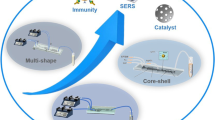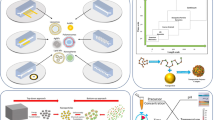Abstract
We review a variety of micro- and nanoparticle formulations produced with microfluidic methods. A diverse variety of approaches to generate microscale and nanoscale particles has been reported. Here we emphasize the use of microfluidics, specifically microfluidic systems that operate in a continuous flow mode, thereby allowing continuous generation of desired particle formulations. The generation of semiconductor quantum dots, metal colloids, emulsions, and liposomes is considered. To emphasize the potential benefits of the continuous-flow microfluidic methodology for nanoparticle generation, preliminary data on the size distribution of liposomes formed using the microfluidic approach is compared to the traditional bulk alcohol injection method.






Similar content being viewed by others
References
Abraham SA et al (2005) The liposomal formulation of doxorubicin. Methods Enzymol 391:71–97
Alivisatos AP (1996) Semiconductor clusters, nanocrystals, and quantum dots. Science 271(5251):933–937
Andresen TL, Jensen SS, Jorgensen K (2005) Advanced strategies in liposomal cancer therapy: problems and prospects of active and tumor specific drug release. Prog Lipid Res 44(1):68–97
Anna SL, Bontoux N, Stone HA (2003) Formation of dispersions using flow focusing in microchannels. Appl Phys Lett 82(3):364–366
Ayyagari AL et al (2006) Long-circulating liposomal contrast agents for magnetic resonance imaging. Mag Reson Med 55(5):1023–1029
Batzri S, Korn ED (1973) Single bilayer liposomes prepared without sonication. Biochim Biophys Acta 298(4):1015–1019
Bessoth FG, deMello AJ, Manz A (1999) Microstructure for efficient continuous flow mixing. Anal Commun 36(6):213–215
Brazhnik KP et al (2005) Directed growth of pure phosphatidylcholine nanotubes in microfluidic channels. Langmuir 21(23):10814–10817
Chan EM, Alivisatos AP, Mathies RA (2005) High-temperature microfluidic synthesis of CdSe nanocrystals in nanoliter droplets. J Am Chem Soc 127(40):13854–13861
Chan EM, Mathies RA, Alivisatos AP (2003) Size-controlled growth of CdSe nanocrystals in microfluidic reactors. Nano Lett 3(2):199–201
Christopher GF et al (2007) Microfluidic methods for generating continuous droplet streams. J Phys D Appl Phys 40:R319–R336
Cottam BF et al (2007) Accelerated synthesis of titanium oxide nanostructures using microfluidic chips. Lab Chip 7(2):167–169
Crosasso P et al (2000) Preparation, characterization and properties of sterically stabilized paclitaxel-containing liposomes. J Control Release 63(1–2):19–30
Dittrich PS et al (2006) On-chip extrusion of lipid vesicles and tubes through microsized apertures. Lab Chip 6(4):488–493
Edel JB et al (2002) Microfluidic routes to the controlled production of nanoparticles. Chem Commun 10:1136–1137
Garstecki P et al (2006) Formation of droplets and bubbles in a microfluidic T-junction - scaling and mechanism of break-up. Lab Chip 6(3):437–446
Gulsen D, Li CC, Chauhan A (2005) Dispersion of DMPC liposomes in contact lenses for ophthalmic drug delivery. Curr Eye Res 30(12):1071–1080
Hung LH et al (2006) Alternating droplet generation and controlled dynamic droplet fusion in microfluidic device for CdS nanoparticle synthesis. Lab Chip 6(2):174–178
Ishida T, Harashima H, Kiwada H (2002) Liposome clearance. Biosci Rep 22(2):197–224
Jahn A et al (2007) Microfluidic directed formation of liposomes of controlled size. Langmuir 23(11):6289–6293
Jahn A et al (2004) Controlled vesicle self-assembly in microfluidic channels with hydrodynamic focusing. J Am Chem Soc 126(9):2674–2675
Jensen KF (2001) Microreaction engineering - is small better? Chem Eng Sci 56(2):293–303
Johnson TJ, Ross D, Locascio LE (2002) Rapid microfluidic mixing. Anal Chem 74(1):45–51
Kelly BT et al (2007) Miniaturizing chemistry and biology in microdroplets. Chem Commun (18):1773–1788
Khan SA et al (2004) Microfluidic synthesis of colloidal silica. Langmuir 20(20):8604–8611
Kikuchi H et al (1999) Gene delivery using liposome technology. J Control Release 62(1–2):269–277
Knight JB et al (1998) Hydrodynamic focusing on a silicon chip: mixing nanoliters in microseconds. Phys Rev Lett 80(17):3863–3866
Kremer JMH et al (1977) Vesicles of variable diameter prepared by a modified injection method. Biochemistry 16(17):3932–3935
Kuribayashi K et al (2006) Electroformation of giant liposomes in microfluidic channels. Meas Sci Technol 17(12):3121–3126
LaMer VK, Dinegar RH (1950) Theory, production and mechanism of formation of monodispersed hydrosols. J Am Chem Soc 72(11):4847–4854
Lasic DD (1988) The mechanism of vesicle formation. Biochem J 256(1):1–11
Lin XZ, Terepka AD, Hong Y (2004) Synthesis of silver nanoparticles in a continuous flow tubular microreactor. Nano Lett 4(11):2227–2232
Lin Y-C, Li M, Wang Y-T, Lai T-H, Chaing J-T, Huang K-S (2005) A new method for the preparation of self-assembled phospholipid microtubes using microfluidic technology. Seoul, Korea, pp 1592–1595
Link DR et al (2004) Geometrically mediated breakup of drops in microfluidic devices. Phys Rev Lett 92(5):Art. No. 054503
Litzinger DC et al (1994) Effect of liposome size on the circulation time and intraorgan distribution of amphipathic poly(ethylene glycol)-containing liposomes. Biochim Biophys Acta Biomembr 1190(1):99–107
Luan WL et al (2007) Open-to-air synthesis of monodisperse CdSe nanocrystals via microfluidic reaction and its kinetics. Nanotechnology 18(17):175603 (6 pp)
Mamot C et al (2003) Liposome-based approaches to overcome anticancer drug resistance. Drug Resist Updat 6(5):271–279
Martina MS et al (2005) Generation of superparamagnetic liposomes revealed as highly efficient MRI contrast agents for in vivo imaging. J Am Chem Soc 127(30):10676–10685
Maulucci G et al (2005) Particle size distribution in DMPC vesicles solutions undergoing different sonication times. Biophys J 88(5):3545–3550
Mayer LD et al (2000) Designing liposomal anticancer drug formulations for specific therapeutic applications. J Liposome Res 10(2–3):99–115
Medintz IL et al (2005) Quantum dot bioconjugates for imaging, labelling and sensing. Nat Mater 4(6):435–446
Michalet X et al (2005) Quantum dots for live cells, in vivo imaging, and diagnostics. Science 307(5709):538–544
Mulder WJM et al (2006) Lipid-based nanoparticles for contrast-enhanced MRI and molecular imaging. NMR Biomed 19(1):142–164
Nakamura H et al (2004) Application of a microfluidic reaction system for CdSe nanocrystal preparation: their growth kinetics and photoluminescence analysis. Lab Chip 4(3):237–240
Pavelic Z et al (2005) Development and in vitro evaluation of a liposomal vaginal delivery system for acyclovir. J Control Release 106(1–2):34–43
Puntes VF, Krishnan KM, Alivisatos AP (2001) Colloidal nanocrystal shape and size control: the case of cobalt. Science 291(5511):2115–2117
Ramachandran S et al (2006) Cisplatin nanoliposomes for cancer therapy: AFM and fluorescence Imaging of cisplatin encapsulation, stability, cellular uptake, and toxicity. Langmuir 22(19):8156–8162
Reiss P, Bleuse J, Pron A (2002) Highly luminescent CdSe/ZnSe core/shell nanocrystals of low size dispersion. Nano Lett 2(7):781–784
Sadava D, Coleman A, Kane SF (2002) Liposomal daunorubicin overcomes drug resistance in human breast, ovarian and lung carcinoma cells. J Liposome Res 12(4):301–309
Saito R et al (2005) Gadolinium-loaded liposomes allow for real-time magnetic resonance imaging of convection-enhanced delivery in the primate brain. Exp Neurol 196(2):381–389
Schmid MH, Korting HC (1994) Liposomes - a drug carrier system for topical treatment in dermatology. Crit Rev Ther Drug Carrier Syst 11(2–3):97–118
Shestopalov I, Tice JD, Ismagilov RF (2004) Multi-step synthesis of nanoparticles performed on millisecond time scale in a microfluidic droplet-based system. Lab Chip 4(4):316–321
Sounart TL et al (2007) Spatially-resolved analysis of nanoparticle nucleation and growth in a microfluidic reactor. Lab Chip 7(7):908–915
Stroock AD et al (2002) Chaotic mixer for microchannels. Science 295(5555):647–651
Sugiura S et al (2001a) Interfacial tension driven monodispersed droplet formation from microfabricated channel array. Langmuir 17(18):5562–5566
Sugiura S et al (2001b) Preparation characteristics of monodispersed water-in-oil emulsions using microchannel emulsification. J Chem Eng Japan 34(6):757–765
Szoka F, Papahadjopoulos D (1980) Comparative properties and methods of preparation of lipid vesicles (liposomes). Annu Rev Biophys Bioeng 9:467–508
Templeton NS et al (1997) Improved DNA: liposome complexes for increased systemic delivery and gene expression. Nat Biotechnol 15(7):647–652
Thorsen T et al (2001) Dynamic pattern formation in a vesicle-generating microfluidic device. Phys Rev Lett 86(18):4163–4166
Trindade T, O’Brien P, Pickett NL (2001) Nanocrystalline semiconductors: Synthesis, properties, and perspectives. Chem Mater 13(11):3843–3858
Wagner A et al (2002) The crossflow injection technique: an improvement of the ethanol injection method. J Liposome Res 12(3):259–270
Wang HZ et al (2004) Continuous synthesis of CdSe-ZnS composite nanoparticles in a microfluidic reactor. Chem Commun (1):48–49
Wang HZ et al (2002) Preparation of titania particles utilizing the insoluble phase interface in a microchannel reactor. Chem Commun (14):1462–1463
Wu L et al (2006) Droplet formation in microchannels under static conditions. Appl Phys Lett 89(14):Art. No. 144106
Author information
Authors and Affiliations
Corresponding author
Additional information
Official contribution of the National Institute of Standards and Technology; not subject to copyright in the United States of America.
Rights and permissions
About this article
Cite this article
Jahn, A., Reiner, J.E., Vreeland, W.N. et al. Preparation of nanoparticles by continuous-flow microfluidics. J Nanopart Res 10, 925–934 (2008). https://doi.org/10.1007/s11051-007-9340-5
Received:
Accepted:
Published:
Issue Date:
DOI: https://doi.org/10.1007/s11051-007-9340-5




